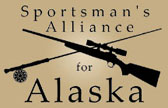Teshekpuk Lake
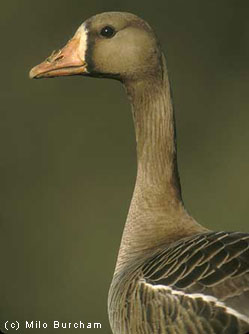
Image use courtesy Audubon Alaska.
Controversial Leasing at Teshekpuk Lake Deferred in Latest BLM Plan
On May 16, 2008 the Secretary of Interior announced that the Bureau of Land Management (BLM) would defer additional oil and gas leasing around Teshekpuk Lake in the Northeast National Petroleum Reserve-Alaska (NPRA) for at least 10 years. The decision came with the release of a final revised environmental statement and activity plan for Northeast NPRA, after a lawsuit blocked a controversial September 2006 lease sale in that area.
The BLM would not open 219,000 acres of Teshekpuk Lake and its islands to oil and gas leasing according to the preferred alternative selected by the agency in its Supplemental Final Integrated Activity Plan/Environment Impact Statement (IAP/EIS). The plan's preferred alternative would also defer leasing for 10 years on 430,000 acres north and east of Teshekpuk Lake that are currently unavailable for leasing.
“This plan provides a balanced approach to energy development and wildlife protection, and forms a solid basis for the Bureau of Land Management to proceed with an oil and gas lease sale later this year,” said Secretary of the Interior Dirk Kempthorne.
Waterfowl hunters and sportsmen’s groups from across the nation had contacted Sec. Kempthorne in late 2007, asking that the protections around the Teshekpuk Lake area remain in place. This area is one of the most internationally important wetland complexes and has been protected by every Presidential administration for the past 30 years. Waterfowl that spend time at Teshekpuk Lake are harvested every season by hunters in every flyway in North America. The engagement of hunters from all across the country as well as groups like Ducks Unlimited, Delta Waterfowl, the Izaak Walton League of America helped to ensure that waterfowl from arctic Alaska will continue to fly south each autumn. While the BLM plan does not provide permanent protection for the Teshekpuk Lake area, the 10-year deferral buys additional time to continue working for permanent protection for one of North America’s most valuable wetlands.
The Sportsman’s Alliance for Alaska would like to thank all the groups and individuals who took time to contact the BLM on this important issue. The Teshekpuk Lake conservation petition will continue to be available for signature, as we build a larger voice for future Teshekpuk Lake protection efforts.
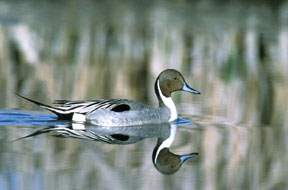
© D. Menke, USFWS
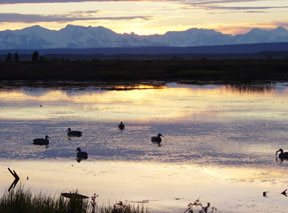
© Ann Rothe
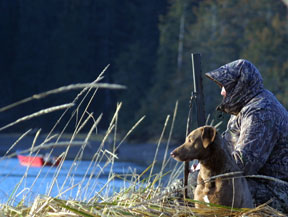
© Ann Rothe
What they’re saying… Excerpts of Public Comments on Proposed Leasing at Teshekpuk Lake
“America’s hunters should not be forced to choose between our way of life and our energy future. Americans can develop oil elsewhere and invest in clean renewable energy. There’s no need to trash the wetlands around Teshekpuk Lake. Destroying our best wildlife habitat for short-term gain is not only a waste, it’s a needless waste.”
- Scott Hed, Director,
Sportsman’s Alliance for Alaska
“Given the unique ecological features of the Teshekpuk Lake area, the abundance and special character of waterfowl resources, and the national and international public interests in the resources of the NPR-A… The sensitive goose molting area should not be offered for leasing… The Pacific Flyway Council also recommends that the Teshekpuk Lake Special Area be given permanent protection from future development…”
- Pacific Flyway Council letter dated 7/2/04
“Our staff has extensive field knowledge of the Northeast Planning Area… We have a strong interest in the waterfowl habitats of NPR-A that support abundant and critical migratory bird resources, especially those on the coastal plain, including Teshekpuk Lake Special Area (TLSA) and the Ikpikpuk Delta.
“The critical goose molting and staging area in the TLSA should not be offered for leasing.”
- Ducks Unlimited letter dated 8/18/04
“Proposals to sell oil and gas leases in the region may dramatically impact the region's rich waterfowl and wildlife values. Teshekpuk Lake and the associated wetland complexes comprise some of the most important waterfowl habitat in Alaska. This wetland-rich landscape serves as key habitat for waterfowl and other birds during crucial periods of their lifecycle and as such, any degradation of this habitat may have unforeseen consequences for these species.”
- Delta Waterfowl letter dated 9/12/06
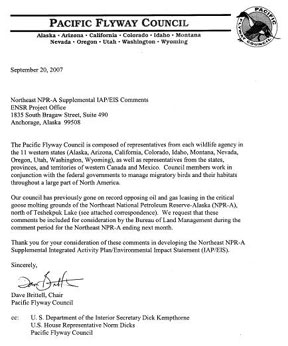
Click image to read official comments from the
Pacific Flyway
Council
on
the management of
Teshekpuk Lake (PDF file size 420k).
TAKE ACTION!
Sign the Petition
Click here to read and sign the petition to protect the waterfowl and wetlands of Teshekpuk Lake.
Sign-on Letter
Contact Scott Hed, Director for the Sportsman’s Alliance for Alaska to receive a copy of a national sign-on letter to Secretary of the Interior Dirk Kempthorne, asking him to continue the long tradition of protection for the Teshekpuk Lake area and to find out how your local or state organization can join other groups from across the country in signing the letter.
Geese or Gas
Click here to view the Chris Madson article “Geese or Gas” from the Nov. 2004 issue of Wildfowl.
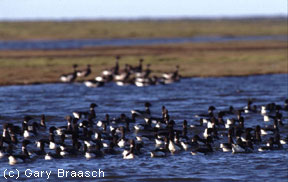
Image use courtesy Audubon Alaska.
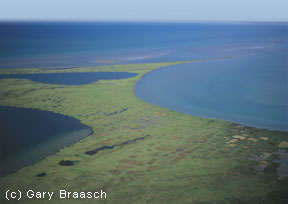
Image use courtesy Audubon Alaska.
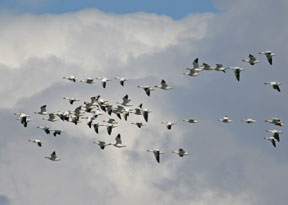
© D. Dewhurst, USFWS
Background
The Bureau of Land Management (BLM) recently released a draft Supplemental EIS (SEIS) to try to address findings of a federal district court, which blocked a proposed lease sale in the Teshekpuk Lake area last September. While this SEIS does not contain a “preferred alternative,” the alternatives are unchanged from those contained in previous documents, and it seems clear from the purpose section and the comments of BLM officials that it is the intent to hold another oil and gas lease sale in the Teshekpuk Lake area as early as next summer or fall.
Why should this matter to you? Well, as fall waterfowl hunting seasons are rapidly approaching, consider the following:
Teshekpuk (pronounced teh-shek-puk), located in the National Petroleum Reserve – Alaska, lies to the west of Prudhoe Bay, the largest oil field in North America, on Alaska’s North Slope. Teshekpuk provides breeding and summering habitat for myriads of waterfowl that each autumn migrate across Canada, the United States, and Mexico.
The vast maze of lakes, wetlands, and rivers around Teshekpuk Lake is critical to the continued survival and productivity of hundreds of thousands of ducks, geese and swans that nest, raise young and molt on Alaska’s Arctic Coastal Plain wetlands. These wetlands support:
- Up to 37,000 molting brant – 30% of all brant in the Pacific flyway.
- Up to 35,000 greater white-fronted geese – 6% percent of the mid-continent breeding population (Central and Mississippi flyways).
- Tens of thousands of Canada and snow geese and tundra swans (Central and Atlantic flyways).
- Tens of thousands of long-tailed ducks and pintails – a species below North American population objectives.
- Nesting spectacled eiders – a “threatened” species under the federal Endangered Species Act.
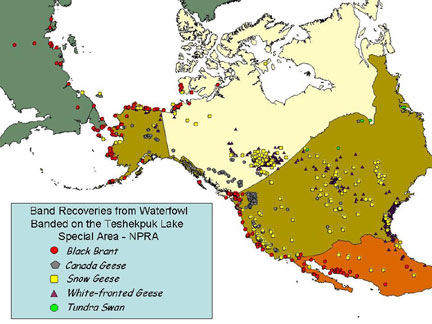
© United States Geological Survey
Click on Map to Enlarge
This map (courtesy US Geological Survey) shows locations of band recoveries from birds banded at the Teshekpuk Lake Special Area.
Note the concentrations of Black Brant, Canada Geese, and Snow Geese in the Pacific flyway and the concentrations of White-fronted Geese and Snow Geese in the Central and Mississippi flyways, and the range distribution as far south as central Mexico. (If the map were to include recoveries of waterfowl banded in areas very near the Teshekpuk Lake Special Area, it would also show a large number of Tundra Swans concentrated in the Great Lakes and Mid-Atlantic regions.)
Clearly, waterfowl hunters across the nation have a stake in the discussion over the future of Teshekpuk Lake’s valuable wetlands.
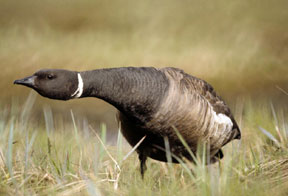
© T. Bowman, USFWS
Thankfully, this waterfowl mecca has enjoyed protected status for the past three decades. The Carter Administration in 1977 designated three “special areas” in the Reserve, including one at Teshekpuk Lake and its surroundings. In 1983, the Reagan Administration advanced an oil and gas lease sale in the northeast Reserve but also established a core no-lease zone of more than 200,000 acres of wetland habitat north of the lake. In 1998, the Clinton Administration expanded this no-lease zone to nearly 600,000 acres, while opening 87 percent of the northeast Reserve to oil and gas leasing.
The oil industry took advantage of these openings and, to date, has nearly 1.5 million acres under lease. There are commercial quantities of oil on some lease tracts, and the industry is now moving to develop those sites and send the oil to the Trans-Alaska Pipeline at Prudhoe Bay. This will be the first-ever commercial production of oil from the Reserve.
Despite the fact that three different presidents acknowledged Teshekpuk Lake’s incredible value as a secure and remote site for molting and nesting migratory waterfowl, the federal Bureau of Land Management (BLM) announced in 2003 that it would consider opening the no-lease zone in the northeast Reserve to exploration and development. Then, in January 2005, the BLM announced plans to open 100 percent of the area north and east of Teshekpuk Lake to oil and gas leasing, effectively reversing nearly 30 years of protection.
Objections to these plans have come from the Wildlife Management Institute, U.S. Fish & Wildlife Service, Environmental Protection Agency, North Slope Borough, Ducks Unlimited, Delta Waterfowl, California Waterfowl Association, Pacific Flyway Council, the Wildlife Society, International Wild Waterfowl Association, Camp Fire Club of America, Washington Brant Foundation, and others.
In September 2006, a federal district court blocked a proposed lease sale for the Teshekpuk Lake area, finding that BLM failed to address cumulative impacts with the proposed sale. Unfortunately, BLM seems likely to “stay the course” and continue with a lease sale for the Teshekpuk Lake area as early as summer or fall 2008. Once again, waterfowl hunters and the organizations to which they belong must join professional wildlife managers, biologists and other conservationists in the call for BLM to keep the Teshekpuk Lake area off limits to oil and gas development. If not, hunting seasons in the not-too-distant future may very well suffer.
